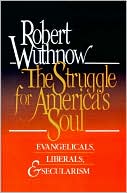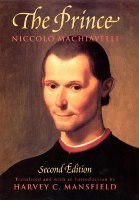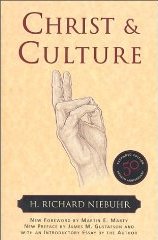
The Struggle for American’s Soul: Evangelicals, Liberals and Secularism. By Robert Wuthnow. Eerdmans Publishing, 1989. 183 pages. $22.00.
The title of Robert Wuthnow’s book, The Struggle for America’s Soul, offers two assumptions intrinsically tied to the thesis and purpose of this book. First, it assumes that America has a soul and second, that there is a battle for its ownership between Evangelicals and Liberals. Robert Wuthnow currently holds the Gerhard R. Andlinger professorship of sociology at Princeton University. He is an accomplished author and scholar with recent published works that include, After the Baby Boomers: How Twenty- and Thirty-Somethings Are Shaping the Future of American Religion; America and the Challenges of Religious Diversity; and Saving America? Faith-Based Services and the Future of Civil Society. As the director of the Center for the Study of Religion at Princeton University, Wuthnow is widely recognized as one of the leading scholars in the field of sociology of religion. Essentially, in this book, Wuthnow seeks to study, from a sociologist’s perspective, the struggle in American religion that “has roots in different views of the Bible, in different styles of moral reasoning, and even in different concepts of spirituality” (xii).
This is not a novel approach, however, to study religion from a sociological lens. In such classical works by Emile Durkheim, Max Weber, Alexis de Tocqueville and more recently, Robert Bellah, studying religion seems a common niche for sociologists to engage intellectually. It is, however, the uniqueness of this book to study the new contours of American faith as acutely defined by the debates between Evangelicals and Liberals. If the lines between these two camps are as boldly demarcated as he initially puts forth, then the goal of this book is to seek coherence between them. In other words, Wuthnow wants to find a middle-way that could potentially bridge these polarized sectors.
Wuthnow introduces his work by first recapitulating the main tenants of America’s voluntary sector, namely the non-profit. It is within this sector that Wuthnow frames American religion in the tradition of other social scientists as mentioned earlier. As distinctive from other social scientists, however, is Wuthnow’s intentional conceptualization of American religion as belonging to or labeled within the non-profit sector. While other social theorists would categorize religion as belonging to either the public or private sector, Wuthnow uses a “homely” image of an orange as a metaphor to identify each sector and offer religion its own wedge. For the purpose of this book review, an in-depth analysis is unnecessary, but it is sufficient to say, as with all metaphors, its explanatory power is limited. The non-profit sector of American society thus provides a framework for Wuthnow’s discussion of religion as an institution. By framing American religion in this fashion, Wuthnow can take on the task of actively using sociological tools for diagnosing its divorced breakdown and role in the third sector. For example, he argues that one of the major social changes that happened to American religion because of the broader social environment was its adaptation to the increased secularization of the American landscape after World War II. He states, “One of the most important, albeit gradual, changes that has taken place in American religion since World War II has been a decline in the tensions between Protestants and Catholics, between Christians and Jews, and between different Protestant denominations” (15).
If these traditional lines of demarcation are no longer representative of the divide in American religion, then what new “struggle” will take its place? For Wuthnow, it is best characterized not by how each side views the other, but by their common observations. He summarizes: “Apart from the colors in which the two sides are portrayed, though, one finds general agreement on the following points: (a) the reality of the division between two opposing camps; (b) the predominance of “fundamentalist,” “evangelicals,” and “religious conservatives” in one and the predominance of “religious liberals,” “humanists,” and “secularists” in the other; and (c) the presence of deep hostility and misgiving between the two (22).
Moving away from merely sociological descriptions, Wuthnow also wants to understand this divide and provide some points of reference. He makes his case by tying tensions to an already disjointed political arena. By suggesting that some of the factors that contributed to a fracture within American religion were motivated by a political agenda and an overall change in the American landscape, Wuthnow makes the claim that religion “is subject to its environment” (37).
To contextualize some of the debates within American religion as a result of intermingling with the public sphere of politics as well as the positions of Evangelicals and Liberals on several issues, Wuthnow examines several social developments in American society. The first social development, Wuthnow states is, “the idea that these controversies have been reinforced by a revival of religious sentiment” (46). Although polling the American public about the state of their religious commitment yields mixed results, an apparent connection between the intensity of which public issues has been debated is a strong indicator of increased religiosity. The second social development is identified as a newfound organization of religious people within the public sphere to collectivize as a special purpose group. In other words, it is these groups of people, as exampled by the National Council of Churches or the National Association of Evangelicals, that blur the lines of American religion and public policy (51). A third social development, often best characterized by the liberal spectrum of American religion and widely considered oppositional to the movement of religion into the public sphere is the liberal judiciary system. Epitomized by a constitutional interpretation of religion, which puts a wall of separation between religion and the state, the courts became a powerful institution for both evangelicals and liberals to legitimize their cause (56). Fourthly, there is the exponential growth of governmental influence post World War II era of American society. It is the social programs and public policies of the state that provided American religion with more awareness of its affects on the American public (59). Fifthly, as Wuthnow puts it, “it’s been suggested that these controversies have deepened because of a change in the class structure of American society.” According to sociologist Peter Berger, this new class of people procures higher degrees of education, move upwards in professional occupation and live lifestyles that are more cosmopolitan. Moreover, the rise of this new class also instigated an increase in religious fundamentalism that acts to counter their liberal tendencies. Resultantly, Wuthnow brings to the fore a new way of contextualizing the Evangelical/Liberal debate to pose new questions and hopefully new strategies for rapprochement (66). Wuthnow’s task is still far from finished. He attempts to exemplify some of his sociological dimensions at work in American religion by looking at Presbyterianism for prospects of reconciliation.
At the core of Wuthnow’s project for understanding the Evangelical and Liberal debate is the relationship between state expansion and civil privatism. He surveys some of the arguments for and against the expansive influence of the state and its effects on civil privatism. The interplay between the public and private spheres of American society expands his work for asserting that religion cannot be assessed outside of these forces. Although this hypothesis hinges on arguments that redefine the boundaries of civil privatism in light of the increased participation in voluntary associations, Wuthnow still believes it can be empirically assessed (106). He examines through data and empirical analysis, that religion encourages civic involvement. Some of the empirical evidence includes church membership data obtained from surveys in 1952 and 1981 sponsored by the National Council of Churches. Since church membership offers one of the best expressions of voluntary association in American society, it also offers the widest pool of data from which a correlation between state expansion and church membership can be assessed. From the data, Wuthnow argues for a “balanced perspective on the role of the modern welfare state in conjunction with arguments about civil privatism” (114). Rounding out his project for framing developments in American religion within public social institutions are several examples, one of which is most noticeably apparent in today’s religious culture, the televangelist. The role media plays for American religion and especially as a medium through which state influence and public matters coalesce, exhibit paradoxical properties. In example, Wuthnow posits that American religion is becoming increasingly privatized as a result of the publicizing of religion through media. In other words, it is the increase in televangelism, as a phenomenon of Evangelicalism in American society and the emergence of couch potato faith that has actually reduced the communal properties of religion as a voluntary association. The result is for Wuthnow, a promotion of religious passivisity through religious television (128). Although several arguments against this position offer convincing thoughts, Wuthnow remains essentially balanced in affirming causal relationships. Wuthnow presents a hypothetical case of Mrs. Mabel as effectually embodying this paradoxical relationship between American faith and the public domain.
Wuthnow presents another factor as contributing to the divide in American religion. Namely, it is the role science played as oppositional to religion both historically and contemporarily. Is increase in exposure to the sciences a factor in ones disbelief (or belief) in God? The perennial question lingers in the mind of Wuthnow as he offers to tackle some of misconceptions of the debate between religion and science through the lens of a sociologist. Some interesting anomalies include a higher incidence of refuting religion or at the very least critical skepticism among scientists that study the social sciences and humanities versus the physical or biological sciences. Wuthnow attributes this anomaly to the increased “scholarly distance” that the former enjoys (150). As with other socially constructed phenomena like knowledge and belief, Wuthnow argues that a sociological study of the sciences shows similar qualities. In other words, science or at least the worldview that frames the study of the sciences exhibits the same sociological factors as one’s belief system (151). Wuthnow borrows Peter Berger’s coined phrase, “plausibility structure” to define the sociological realities of scientists. He states, “In other words, scientists who lack clearly codified paradigms and strong communication networks turn to symbolic modes of differentiating themselves from everyday reality in order to maintain the plausibility of their scientific orientations – orientations that are inevitably precarious in relation to the paramount reality of everyday life” (153). As a result, scientists that are better able to remove themselves from reality – the realm in which religion plays a particularly large role – are more likely “to make the transition successfully into the scientific role” (154). In conclusion, Wuthnow interprets the conflict between religion and science as more a function of the scientific world trying to “carve out a space in which to work by dissociating themselves from the powerful claims religion has been able to make throughout history, and which it still appears to command over the everyday life of American society” (157).
In the concluding chapter of Wuthnow’s book, he offers some prospects to bridge the gap between Evangelicals and Liberals. The highest prospect is, of course, for Wuthnow an increased interest in the scholarly sociological study of Evangelicalism and Liberalism. Although Evangelical scholarship is largely marginalized because of their historical disconnect from liberal research universities with large endowments, Wuthnow admits that scholarship is never accomplished in a vacuum or without the inevitability of bringing one’s own subcultures to the conversation (167). Noting that these and other marginalizing factors have contributed to the lack of scholarly evangelical research, Wuthnow urges Evangelical scholarship to turn its disabling stigma to an enabling self-reflection. Wuthnow calls for Evangelicals to participate in research of Evangelicalism because, “evangelical social scientists may be in an especially privileged situation to mediate the conflict between liberal and conservative Christians because of their own backgrounds and intellectual dispositions” (175).
Robert Wuthnow’s work is a most welcoming study and contribution to the field of the sociology of religion. He resonates well with both Liberal and Evangelical thinkers and offers them a way to come to grips with the sociological dimensions of their respective worldviews. While treating each side with a hallmark objective disposition, Wuthnow gives ample flexibility for interpretation while remaining tightly cogent in his arguments. Like any good work, however, it raises more questions than answers, especially in terms of the assumptions of some of his arguments. The abstract theorizing in sociological terms does very little in offering practical or applicable mechanisms for bridging the Evangelical and Liberal divide. Some issues that I have come across in this book mostly circle on the lack of theological or psychological avenues of association. Wuthnow does very little to entertain theological differences between Evangelicals and Liberals as a nuanced sociological phenomenon. In his defense, however, Wuthnow’s work is admittedly a survey of American religion through a sociological lens and not a theological apologetic. Another gripe I have with Wuthnow’s work is his total omission of a more moderate and arguably reticent middle group that constitutes the middle sector between Evangelicalism and Liberalism. It is difficult to include the moderate middle in most of his dealings with American religion when he does not properly define, in other terms besides sociological ones, what exactly makes an Evangelical person, evangelical in faith and a Liberal person, liberal in faith. Overall, Wuthnow’s work constitutes a necessary read for anyone that has a vested interest in their beliefs, faith and community.
“Dan” Chinhyo Kim
Boston University


